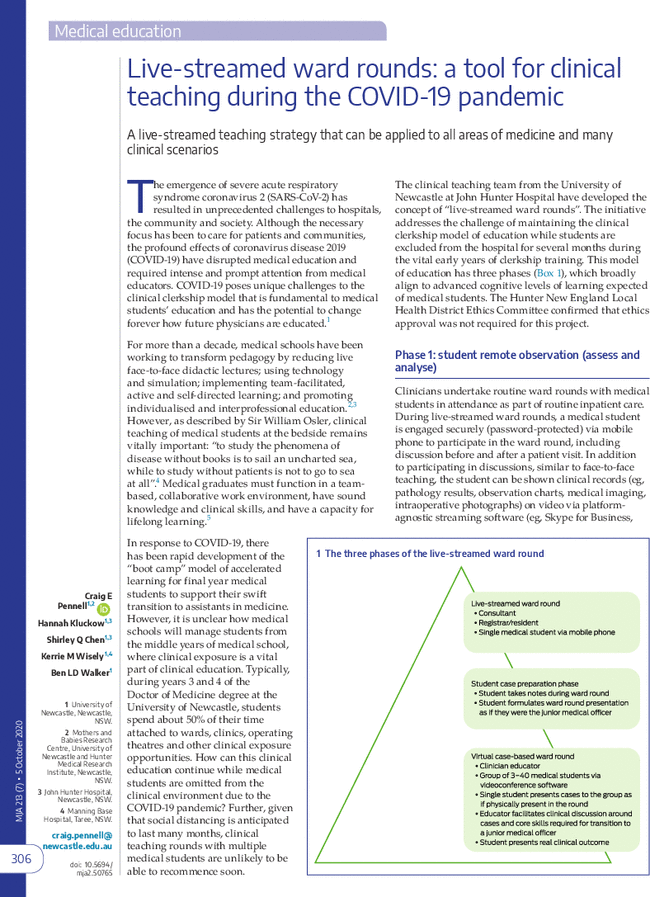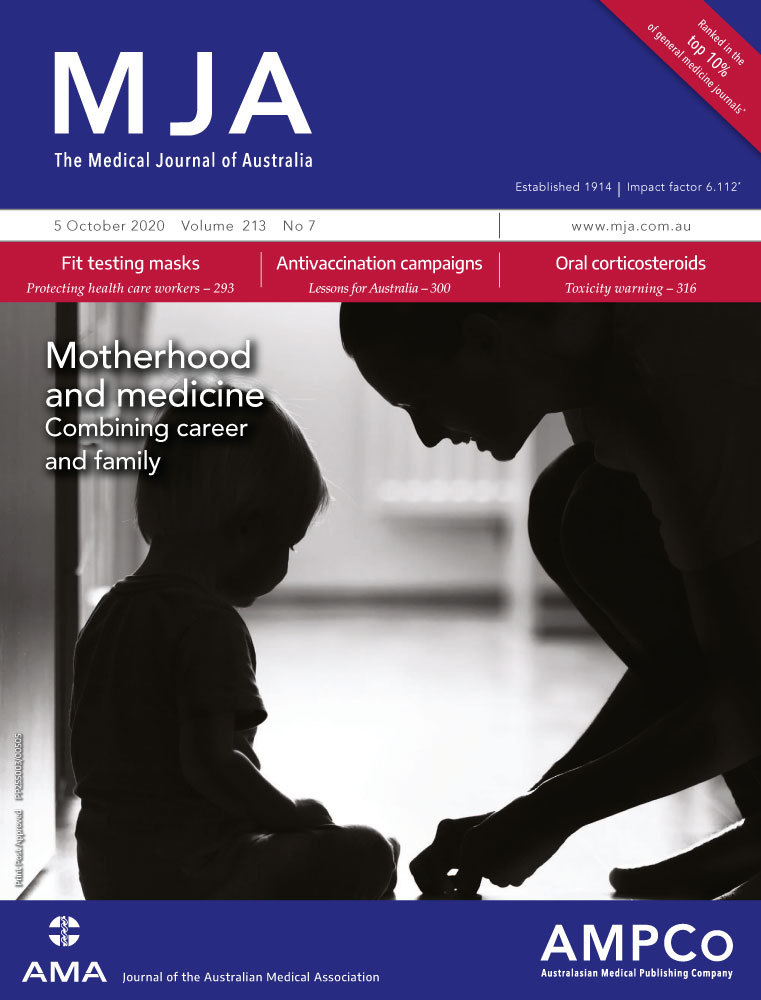Live-streamed ward rounds: a tool for clinical teaching during the COVID-19 pandemic
Corresponding Author
Craig E Pennell
University of Newcastle, Newcastle, NSW
Mothers and Babies Research Centre, University of Newcastle and Hunter Medical Research Institute, Newcastle, NSW
[email protected]Search for more papers by this authorHannah Kluckow
University of Newcastle, Newcastle, NSW
John Hunter Hospital, Newcastle, NSW
Search for more papers by this authorShirley Q Chen
University of Newcastle, Newcastle, NSW
John Hunter Hospital, Newcastle, NSW
Search for more papers by this authorKerrie M Wisely
University of Newcastle, Newcastle, NSW
Manning Base Hospital, Taree, NSW
Search for more papers by this authorCorresponding Author
Craig E Pennell
University of Newcastle, Newcastle, NSW
Mothers and Babies Research Centre, University of Newcastle and Hunter Medical Research Institute, Newcastle, NSW
[email protected]Search for more papers by this authorHannah Kluckow
University of Newcastle, Newcastle, NSW
John Hunter Hospital, Newcastle, NSW
Search for more papers by this authorShirley Q Chen
University of Newcastle, Newcastle, NSW
John Hunter Hospital, Newcastle, NSW
Search for more papers by this authorKerrie M Wisely
University of Newcastle, Newcastle, NSW
Manning Base Hospital, Taree, NSW
Search for more papers by this author
Supporting Information
| Filename | Description |
|---|---|
| mja250765-sup-0001-supinfo.pdfPDF document, 201.9 KB | Supplementary table |
Please note: The publisher is not responsible for the content or functionality of any supporting information supplied by the authors. Any queries (other than missing content) should be directed to the corresponding author for the article.
References
- 1Rose S. Medical student education in the time of COVID-19. JAMA 2020;. https://doi.org/10.1001/jama.2020.5227. [Epub ahead of print].
- 2Emanuel EJ. The inevitable reimagining of medical education. JAMA 2020;. https://doi.org/10.1001/jama.2020.1227. [Epub ahead of print].
- 3Skochelak SE, Stack SJ. Creating the medical schools of the future. Acad Med 2017; 92: 16–19.
- 4Osler W. On the need of a radical reform in our teaching methods: senior students. Med News 1903; 82: 49–53.
- 5Haeri A, Hemmati P, Yaman H. What kind of curriculum can better address community needs? Problems arisen by hypothetical-deductive reasoning. J Med Syst 2007; 31: 173–177.
- 6Bahmanbijari B, Beigzadeh A. Medical professionalism: teaching and assessment tools. Rep Health Care 2015; 1: 69–72.
- 7Beigzadeh A, Bahaadinbeigy K, Adibi P, et al. Identifying the challenges to good clinical rounds: a focus-group study of medical teachers. J Adv Med Educ Prof 2019; 7: 62–73.
- 8Faustinella F, Jacobs RJ. The decline of clinical skills: a challenge for medical schools. Int J Med Educ 2018; 9: 195–197.
- 9Billett S. Learning in the workplace: strategies for effective practice. Sydney: Allen and Unwin, 2001.
- 10Sheehan D, Wilkinson T, Paltridge D. A tool to evaluate effective learning environments within clinical attachments for interns. Focus Health Prof Educ 2008; 10: 1–10.
- 11Kandiah DA. Perception of educational value in clinical rotations by medical students. Adv Med Educ Pract 2017; 8: 149–162.
- 12Sheehan D, Bagg W, de Beer W, et al. The good apprentice in medical education. N Z Med J 2010; 123: 89–96.
- 13Sheehan D, Wilkinson TJ. Maximising the clinical learning of junior doctors: applying educational theory to practice. Med Teach 2007; 29: 827–829.
- 14Al Kadri HM, Al-Moamary MS, Elzubair M, et al. Exploring factors affecting undergraduate medical students’ study strategies in the clinical years: a qualitative study. Adv Health Sci Educ Theory Pract 2011; 16: 553–567.
- 15Wittert GA, Nelson AJ. Medical education: revolution, devolution and evolution in curriculum philosophy and design. Med J Aust 2009; 191: 35–37. https://www.mja.com.au/journal/2009/191/1/medical-education-revolution-devolution-and-evolution-curriculum-philosophy-and.




